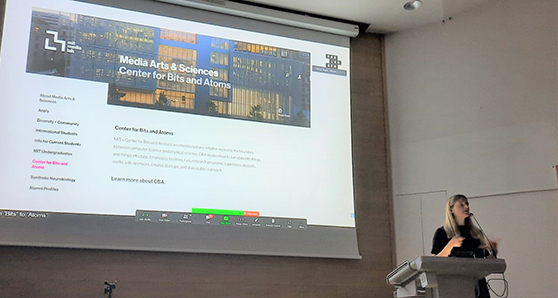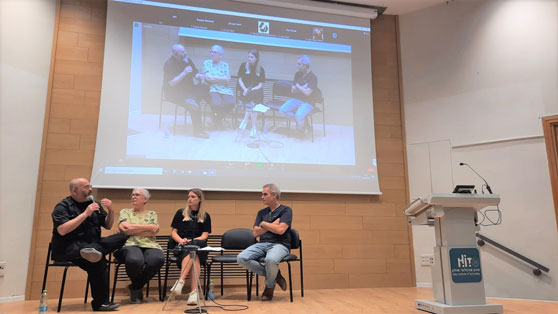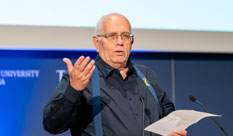More:
News & Stories
Design. Code. Person - Faculty of Design's Conference
How the use of computer code in design changes the way we design. How do we consume design?

The Faculty of Design's conference held at the Institute, presented key issues in the field.
According to Dr. Yael Eylat Van Essen, editor of the conference, it is not possible today to talk about design without the involvement of computer technologies, even in professions that were previously linked to manual work and relied on old traditions. Digital technologies touch on aesthetic properties of the designed objects, real or virtual as well as on their functional aspects and modes of use.
The last decade has been characterized by a profound change as digital technologies are embedded everywhere and change the human conduct around the world. While also touching on the cognitive and creative aspects, they open the design field to possibilities that are beyond human intuition and to a scale that could not have been thought of before. Technologies such as Artificial Intelligence, Big Data, open source, virtual reality, and augmented reality, not only allow the world to be shaped differently but also allow for new types of interactions. With the new tools we design smart environments, we can "converse" with objects, assimilate within virtual spaces, influence phenomena we previously considered "natural phenomena" and intervene in the behaviors of substances by changing their genetic code.
The keynote speaker at the conference was Kate Amsterdam, who holds a bachelor's degree in UNSW design and a master's degree from the Department of Arts and Society from the University of Utrecht in the Netherlands. She is leading a research project in the field of distributed design at FabLab Barcelona at the Institute of Advanced Architecture of Catalonia. She is also involved with MAX (Makers’ eXchange) project, a pilot policy project, co-funded by the European Union.

Kate Amsterdam
In her lecture: Hyper Global x Hyper Local, Future Decoding Design from 'Bits' to 'Atoms, Armstrong introduced the issue of distributed design and noted that this is a phenomenon that is emerging at the intersection between non-industrial design and manufacturing. As digital design and manufacturing tools become more accessible on a home scale and the logic of distributed manufacturing methods gains a broader understanding, the popularity of a networked approach to small-scale design and manufacturing grows. At the same time, a local approach to design is formed, in which intersections remotely connected via digital platforms, not only transmit data, but act as portals to collaborative networks with a common denominator.
At the home scale, the approach helps with hyper-local and hyper-custom design solutions with the ability to meet individual user needs. In addition, it provides a place for diversity in materials, and offers techniques that express different voices and craft practices. The digital layer can include communications, tools and platforms that can expand the boundaries of design and physical production spaces. These tools open up the possibility of remote collaboration in various aspects of ‘design to production’ processes, and offer open access to educational resources and building capacity for professional self-development.
"The design world is facing many opportunities now," Armstrong says, "and the question is how we can change the nature of our lives from industrialization to a sustainable lifestyle that is based, among other things, on using networks and sharing information about design."
This issue is especially important because the sustainable paradigm does not exist and we can combine innovation and as means available to us to create something new.
The project I am working on that funded by the European Union, looks at the role of designers in implementing this new paradigm. "

Design. Code. Person - Conference panel
Armstrong admits that an effort is needed to create the change and precisely the enforced Covid 19 period, in which the world partially stood still, provided a suitable opportunity to see how things could be done differently. "When we rely less on central systems there will also be less pollution and also more people will be allowed to take part in the processes. The era of ' rock star designers' who hold the knowledge in their hands ends and now is the time to share knowledge on a global scale.
Architect Nof Nathanson, talked about how in recent years we have witnessed the second phase of the digital revolution. According to her, if in the first stage computers replaced the pencil and architects received innovative tools for design, then in the second stage they receives innovative tools for production. This is not about comfort; it is a fundamental liberation of architectural thinking. Not only are 3D printers and robotic arms now available to all; Day by day, researchers are learning more and more ways to "hack" these machines -recode them and change their original purpose. These are architectural machines that serve as a flexible means of production in the hands of the designer.
This revolution marks a turning point in the architectural discipline. The new tools expand the boundaries of the profession, and allow the architect to take control of the entire process -of the design, installation, of the production tools and in the construction itself. In this way planners win unprecedented creative choices.
Tamara Efrat is a multidisciplinary designer and entrepreneur, who gave a lecture on the topic: from Craft to Technology and back to Craft.
The possibilities for interpretation and contemporary uses of textiles and ceramics using parameter tools. The lecture addressed two projects created by Efrat that focus on developing tools designed to create new Craft, and the question of how an object can serve as a medium for communication between the art world and the computer world, and how such communication can offer a platform for re-examination and re-use of craft.
Dr. Architect Davida Shauman, Senior Lecturer in the Faculty of Architecture and Urban Planning at the Technion and Director of the Smart Environment Laboratory, reviewed his lecture: User-oriented architecture, how advanced sensors and communication technologies are integrated and assimilated in building environments, enabling new types of interactions between humans and buildings. These environments are becoming active partners, that aware of the needs of their users and enable them proactively. Despite that, so far the only way architects, engineers and planners can represent information about buildings today is only statically, not taking into account the dynamic behavior of human beings.
Conference editor: Dr. Yael Eylat Van Essen
Steering Committee: Dr. Yael Eylat Van Essen, Prof. David Rawet
Posted: 04/05/2022
- News & Events
New Collaboration with Sheba Medical Center will qualify nurses to work in a digital environment.
Collaboration between HIT Holon Institute of Technology, the teaching authority of the Sheba Medical Center, and the Sheba-BEYOND virtual hospital will allow training nurses in Israel and around the world to work in a digital...



 Additional programs
Additional programs
